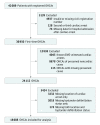Bystander Defibrillation for Out-of-Hospital Cardiac Arrest in Public vs Residential Locations
- PMID: 28297003
- PMCID: PMC5814985
- DOI: 10.1001/jamacardio.2017.0008
Bystander Defibrillation for Out-of-Hospital Cardiac Arrest in Public vs Residential Locations
Abstract
Importance: Bystander-delivered defibrillation (hereinafter referred to as bystander defibrillation) of patients with out-of-hospital cardiac arrests (OHCAs) remains limited despite the widespread dissemination of automated external defibrillators (AEDs).
Objective: To examine calendar changes in bystander defibrillation and subsequent survival according to a public or a residential location of the cardiac arrest after nationwide initiatives in Denmark to facilitate bystander-mediated resuscitative efforts, including bystander defibrillation.
Design, setting, and participants: This nationwide study identified 18 688 patients in Denmark with first-time OHCA from June 1, 2001, to December 31, 2012, using the Danish Cardiac Arrest Registry. Patients had a presumed cardiac cause of arrest that was not witnessed by emergency medical services personnel. Data were analyzed from April 1, 2015, to December 10, 2016.
Exposures: Nationwide initiatives to facilitate bystander resuscitative efforts, including bystander defibrillation, consisted of resuscitation training of Danish citizens, dissemination of on-site AEDs, foundation of an AED registry linked to emergency medical dispatch centers, and dispatcher-assisted guidance of bystander resuscitation efforts.
Main outcomes and measures: The proportion of patients who received bystander defibrillation according to the location of the cardiac arrest and their subsequent 30-day survival.
Results: Of the 18 688 patients with OHCAs (67.8% men and 32.2% women; median [interquartile range] age, 72 [62-80] years), 4783 (25.6%) had a cardiac arrest in a public location and 13 905 (74.4%) in a residential location. The number of registered AEDs increased from 141 in 2007 to 7800 in 2012. The distribution of AED location was consistently skewed in favor of public locations. Bystander defibrillation increased in public locations from 3 of 245 (1.2%; 95% CI, 0.4%-3.5%) in 2001 to 78 of 510 (15.3%; 95% CI, 12.4%-18.7%) in 2012 (P < .001) but remained unchanged in residential locations from 7 of 542 (1.3%; 95% CI, 0.6%-2.6%) in 2001 to 21 of 1669 (1.3%; 95% CI, 0.8%-1.9%) in 2012 (P = .17). Thirty-day survival after bystander defibrillation increased in public locations from 8.3% (95% CI, 1.5%-35.4%) in 2001/2002 to 57.5% (95% CI, 48.6%-66.0%) in 2011/2012 (P < .001) in residential locations, from 0.0% (95% CI, 0.0%-19.4%) in 2001/2002 to 25.6% (95% CI, 14.6%-41.1%) in 2011/2012 (P < .001).
Conclusions and relevance: Initiatives to facilitate bystander defibrillation were associated with a marked increase in bystander defibrillation in public locations, whereas bystander defibrillation remained limited in residential locations. Concomitantly, survival increased after bystander defibrillation in residential and public locations.
Conflict of interest statement
Figures




Comment in
-
Cardiac Arrest in Any Location: The Need for Fewer Bystanders and More Layperson Rescuers.JAMA Cardiol. 2017 May 1;2(5):514-515. doi: 10.1001/jamacardio.2017.0040. JAMA Cardiol. 2017. PMID: 28297005 No abstract available.
Similar articles
-
Out-of-hospital cardiac arrest: Probability of bystander defibrillation relative to distance to nearest automated external defibrillator.Resuscitation. 2018 Mar;124:138-144. doi: 10.1016/j.resuscitation.2017.11.067. Epub 2017 Dec 5. Resuscitation. 2018. PMID: 29217395
-
Association of Public Health Initiatives With Outcomes for Out-of-Hospital Cardiac Arrest at Home and in Public Locations.JAMA Cardiol. 2017 Nov 1;2(11):1226-1235. doi: 10.1001/jamacardio.2017.3471. JAMA Cardiol. 2017. PMID: 28979980 Free PMC article.
-
Out-of-hospital cardiac arrest surveillance --- Cardiac Arrest Registry to Enhance Survival (CARES), United States, October 1, 2005--December 31, 2010.MMWR Surveill Summ. 2011 Jul 29;60(8):1-19. MMWR Surveill Summ. 2011. PMID: 21796098
-
The challenges and possibilities of public access defibrillation.J Intern Med. 2018 Mar;283(3):238-256. doi: 10.1111/joim.12730. Epub 2018 Feb 12. J Intern Med. 2018. PMID: 29331055 Review.
-
Public Access Defibrillation: Is This Making Any Difference? Controversial Issues in Resuscitation from Cardiac Arrest.Card Electrophysiol Clin. 2017 Dec;9(4):551-557. doi: 10.1016/j.ccep.2017.07.006. Card Electrophysiol Clin. 2017. PMID: 29173401 Review.
Cited by
-
Out-of-hospital cardiac arrests in the city of Cape Town metropole of the Western Cape province of South Africa: a spatio-temporal analysis.Cardiovasc J Afr. 2022 Sep-Oct 23;33(5):260-266. doi: 10.5830/CVJA-2022-019. Epub 2022 Jun 8. Cardiovasc J Afr. 2022. PMID: 35687073 Free PMC article.
-
Disparities in Bystander Cardiopulmonary Resuscitation Performed by a Family Member and a Non-family Member.J Epidemiol. 2021 Apr 5;31(4):259-264. doi: 10.2188/jea.JE20200068. Epub 2020 Apr 18. J Epidemiol. 2021. PMID: 32307352 Free PMC article.
-
Bystander performance using the 2010 vs 2015 ERC guidelines: A post-hoc analysis of two randomised simulation trials.Resusc Plus. 2021 May 14;6:100123. doi: 10.1016/j.resplu.2021.100123. eCollection 2021 Jun. Resusc Plus. 2021. PMID: 34223381 Free PMC article.
-
Early risk stratification after resuscitation from cardiac arrest.J Am Coll Emerg Physicians Open. 2020 Apr 23;1(5):922-931. doi: 10.1002/emp2.12043. eCollection 2020 Oct. J Am Coll Emerg Physicians Open. 2020. PMID: 33145541 Free PMC article.
-
How to improve automated external defibrillator placement for out-of-hospital cardiac arrests: A case study.PLoS One. 2021 May 20;16(5):e0250591. doi: 10.1371/journal.pone.0250591. eCollection 2021. PLoS One. 2021. PMID: 34014960 Free PMC article.
References
-
- Caffrey SL, Willoughby PJ, Pepe PE, Becker LB. Public use of automated external defibrillators. N Engl J Med. 2002;347(16):1242-1247. - PubMed
-
- Valenzuela TD, Roe DJ, Nichol G, Clark LL, Spaite DW, Hardman RG. Outcomes of rapid defibrillation by security officers after cardiac arrest in casinos. N Engl J Med. 2000;343(17):1206-1209. - PubMed
-
- Page RL, Joglar JA, Kowal RC, et al. . Use of automated external defibrillators by a US airline. N Engl J Med. 2000;343(17):1210-1216. - PubMed
-
- Kitamura T, Kiyohara K, Sakai T, et al. . Public-access defibrillation and out-of-hospital cardiac arrest in Japan. N Engl J Med. 2016;375(17):1649-1659. - PubMed
-
- Link MS, Atkins DL, Passman RS, et al. . 2010 American Heart Association Guidelines for Cardiopulmonary Resuscitation and Emergency Cardiovascular Care: part 6: electrical therapies: automated external defibrillators, defibrillation, cardioversion, and pacing. Circulation. 2010;122(18)(suppl 3):S706-S719. - PubMed
Publication types
MeSH terms
LinkOut - more resources
Full Text Sources
Other Literature Sources
Medical
Miscellaneous

